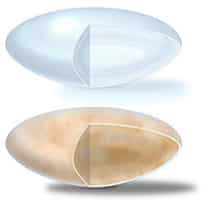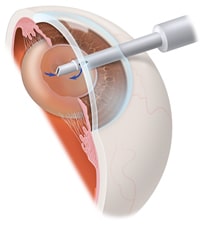Cataract surgery is a procedure performed to improve vision by replacing the lens of an eye clouded by a cataract. Cataracts affect millions of people in the United States each year. Most cataracts are the result of aging, though some form as a result of genetic factors or because of disease or injury.
Candidates for Cataract Surgery

Commonly, the development of cataracts through aging is a gradual process. Patients may not notice early changes in vision and may only become aware of the condition when it is more advanced. Ophthalmologists, however, can detect cataracts by finding the lens opaque upon medical examination. Only medical professionals can rule out other causes for visual disturbance, such as glaucoma or macular degeneration.
Patients who become aware of visual difficulties related to cataracts usually experience clouded, blurred or dim vision especially at night.
Benefits of Cataract Surgery
The benefits of cataract surgery are many and have been proven to greatly enhance the quality of life. Patients who have successful cataract surgery may experience several advantages.
Improved Quality of Vision
Patients experience improved vision after cataract surgery, reporting sharper images and brighter colors, They have less difficulty with many routine tasks, particularly night driving.
Decreased Dependency on Eyeglasses
Many people who have cataract surgery find that they no longer need to wear glasses or that their dependency on glasses is greatly reduced.
Greater Sense of Self-confidence
Cataract surgery most often results in an increased sense of independence, regardless of the age of the patient. Marked improvements have been recorded even in patients with dementia or extreme hearing impairment.
Greater Safety
Research indicates that the improved vision provided by cataract surgery reduces the possibility of falls, making exercise, sports and hobbies more possible. This results in improved physical health, sociability and longer life expectancy.
Procedure of Cataract Surgery

After the pupil is dilated and the area in and around the eye is numbed with anesthesia, a tiny incision is made to insert an ultrasonic probe. The probe emulsifies, or breaks up, the cloudy lens into tiny pieces which are suctioned out of the eye. Once the cloudy lens has been removed, a new artificial lens is implanted. The new lens, known as an intraocular lens or IOL, is often inserted through the original incision. Surgery usually takes only a few minutes to perform, is usually performed outpatient in the doctor's office and is relatively painless.
A very high percentage of patients demonstrate improved vision after the procedure.
A wide range of replacement lenses are available to cataract patients, each offering different advantages for post-surgery vision. The most effective lens to use depends on the patient's individual preferences and goals for their vision. The lenses eliminate the need for glasses or contacts after cataract surgery, providing most patients with convenient, effective results for their specific vision conditions.

Multifocal Intraocular Lenses (IOLS)
AcrySof IQ PanOptix IOL
The AcrySof® IQ PanOptix IOL is an intraocular lens that provides good near, intermediate and distance vision for patients who want to significantly decrease their dependence on glasses or contacts after undergoing cataract surgery.
- The PanOptix IOL is a soft, foldable acrylic lens.
- There is no need for stitches because a smaller incision is made in the eye.
- The PanOptix IOL corrects for both cataracts and presbyopia.
- The implant filters blue light without affecting the quality of vision.
Toric IOLs for Astigmatism
Intraocular lenses are used during cataract surgery to replace the damaged lens of the eye with an implant that clears up and corrects vision, oftentimes leaving patients with little to no dependence on glasses.

Up until now, patients with astigmatism did not have the same opportunities that other cataract patients have had in correcting their condition with the types of IOL lenses that were available. Typically, the astigmatic patient would need an additional surgical procedure, such as refractive surgery or LASIK, to correct their vision after the procedure.
If the patient did not want to undergo another surgical procedure, the only option for correction would be the use of either contact lenses or glasses to address their astigmatism.
Toric IOLs are able to accommodate for the condition of astigmatism. Toric IOLs are specially designed to correct astigmatism along with overall vision during cataract surgery, offering complete vision correction.
Risks of Cataract Surgery
While cataract surgery is a common procedure and is considered quite safe, any surgery poses risks to the patient. In the case of cataract surgery, there is a slightly increased risk of retinal detachment, a painless but dangerous condition. Other risks of cataract surgery may include bleeding or infection.
Recovery from Cataract Surgery
After the operation, the eye is usually covered with a patch. Itching and mild discomfort after cataract surgery are normal and usually disappear within a few days.
For a few days after surgery, the patient uses prescribed eye drops to assist in the healing process and to decrease the risk of infection. Patients should refrain from rubbing the eyes, bending and heavy lifting for several days. In most cases, complete healing takes place within eight weeks.


